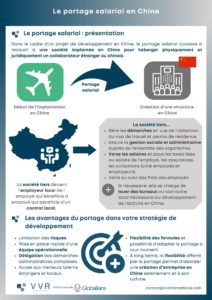Portage vs setting up a business in China: The duel
Portage vs setting up a business in China: The duel
Once the Chinese market has been identified as a real opportunity, there are two main strategies for accelerating your business development in China: portage and setting up a local company. While China continues to be a popular destination for international expansion due to its vast and dynamic market, choosing the best approach to enter requires careful consideration. By simplifying the process, portage appears to be an attractive option for companies wishing to test the waters. On the other hand, setting up a local entity offers an unparalleled level of control and commitment. However, each option comes with its own set of advantages and disadvantages. This article will examine these two strategies in detail, weighing up the pros and cons, to help companies make an informed choice tailored to their needs and objectives in China.
Advantages of Portage services in China
Portage salarial is a solution that enables a company to hire an employee in China without having to set up a local legal entity. Here are the main advantages:
Administrative simplification
Avoid the complexities involved in setting up and managing a local entity. The freelance administration company handles all the administrative, tax and social security formalities for you, and can even physically house your employee in its premises in China.
Financial flexibility
With portage solution, no investment is required to set up your team in China. The only costs are the actual operating costs (salaries, travel expenses, etc.). Companies can therefore test the Chinese market with minimal investment and a limited commitment.
Absence of legal and regulatory risks
The portage company masters Chinese labour legislation and takes care of the employee’s legal obligations and administrative management, thereby reducing the risks for the foreign company.
Speed of implementation
Once the new employee has been selected, companies can start their activities in China almost immediately, without waiting for the long lead times involved in setting up a company.
Disadvantages of portage in China
While portage offers a simplified entry into the Chinese market, it also has its limitations:
Potential long-term costs
Although less expensive initially, portage can become costly over time, particularly if the company wants to increase the number of employees working in China. In this case, portage is a temporary solution until a local legal entity can be set up. VVR International supports companies from the recruitment of their first employee to the setting up of their own entity in China.
Dependence on a third party
Trust in a portage company imposes a dependence that can limit strategic autonomy. This is why it can be a transitional solution. This first stage can be part of a development project. If you are planning to set up a long-term presence in China, we recommend that you use a company offering a strategic diagnosis and a range of services to support your development and ensure the long-term future of your business.
Less control over operations
By delegating the administrative, tax and legal aspects, companies can feel a lack of direct control over their activities and their employees. This can be countered by implementing effective communication and monitoring tools that are accessible in both Europe and China.
Advantages of setting up a business in China
Opting to set up your own business in China is an ambitious move that offers a number of significant advantages:
Full control over operations and strategy
Having your own business gives you total control, enabling you to adjust strategy and operations in line with market needs and opportunities.
Potential for growth and expansion
With a solid structure, companies have the freedom to grow, invest and expand without limitations.
Recognition and credibility in the local market
A local presence, by opening stores or premises dedicated to its business or to the distribution of its products, strengthens the confidence of Chinese consumers and partners, facilitating business relationships.
Cultural and market adaptability
Proximity to the market allows us to understand consumers even better, and to adapt more finely to cultural and commercial specificities.
Disadvantages of setting up a business in China
Despite its advantages, setting up an entity in China is also fraught with pitfalls that should not be overlooked:
A long and complex process
setting up a business in China can be an obstacle course, with lengthy and sometimes opaque administrative, regulatory and legal procedures.
Legal and regulatory risks
China has a distinct legal and regulatory environment that can pose challenges for foreign companies. Failure to comply with regulations can result in severe penalties.
High initial costs
Unlike freelance administration, setting up a business requires a substantial initial investment, particularly in terms of capital, time and resources.
Cultural and linguistic barriers
Cultural differences can lead to misunderstandings and require constant adaptation.
Optimise your expansion in China with VVR International
The decision between portage and setting up a company in China is a crucial one, and largely depends on each company’s objectives, resources and long-term vision. While portage offers a quick and less risky entry into the Chinese market, a long-term vision with ambitions for solid expansion might lean towards setting up a company, despite its initial challenges.
However, this is not a choice to be made alone. With 23 years’ experience and more than 1,000 successful projects under its belt, VVR International is your trusted partner for securing and sustaining your business development in China. VVR International carries out an initial diagnosis and works with you to devise a development strategy tailored to your business. VVR International then has the necessary licences and a dedicated HR team to recruit and support your employee in China or to help you set up an entity in China. Whatever your decision, VVR’s expertise will be a major asset in your conquest of the Chinese market.














